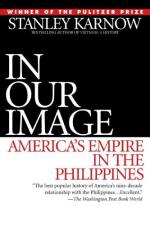|
This section contains 721 words (approx. 2 pages at 400 words per page) |

|
In Our Image: America's Empire in the Philippines Summary & Study Guide Description
In Our Image: America's Empire in the Philippines Summary & Study Guide includes comprehensive information and analysis to help you understand the book. This study guide contains the following sections:
This detailed literature summary also contains Topics for Discussion and a Free Quiz on In Our Image: America's Empire in the Philippines by Stanley Karnow.
The connection between the United States and the Philippines is both long lasting and complex. Since taking the Philippines as a "prize" in the Spanish American war, the U.S. has strayed from seeing the island nation as a conquest to be exploited, a guilty secret to be fixed, and a valuable strategic asset to be kept at any cost. The Filipino perception of the United States has also changed from occupying nation to protector over the years. Many famed historical leaders have found their lives inexorably linked to the Philippines. A partial list includes General Douglas MacArthur, William McKinley, William Robert Taft, explorer Ferdinand Magellan, and Teddy Roosevelt. The love/hate relationship between the two countries is explained in fascinating detail.
The Philippines are discovered by Ferdinand Magellan in 1521 and claimed in the name of Spain. Magellan becomes entangled in a battle between native tribes and is killed. A small portion of his crew survives to circumnavigate the globe. Missionaries soon arrive in the Philippines and begin introducing the natives to Christianity. Over time, Spanish traditions are co-opted by the Filipino people. Trading gradually increases and some locals become educated abroad for the first time. An upper class, land-owning society grows and pushes for reform. The Spanish brutally repress any outspoken Filipinos. Unrest grows, along with a nationalist movement. Emilio Aguinaldo emerges as a leader of a Filipino independence movement. His forces battle with Spanish troops.
The United States drives the industrial revolution and emerges at the end of the nineteenth century with rival factions debating isolationism versus imperialism. Tensions mount over the Spanish occupation of Cuba, and the destruction of the U.S. warship Maine finally pushes the country into war. President McKinley reluctantly lets imperialist factions lead him along. U.S. Commodore George Dewey commands the United States naval fleet, which destroys the Spanish fleet in Manila Bay. Aguinaldo naively believes Dewey's vague statements, thinking the United States will aid the Filipinos in their fight for independence.
American forces arrive at Manila, and the Spanish troops surrender to them instead of the Filipinos. Tensions mount as many planners in the United States are kept in the dark as to just how popular the Filipino independence movement is. War breaks out, and a two-year bloody campaign ensues. Filipinos resort to guerilla tactics and major atrocities become common on both sides. Enthusiasm for the war wanes at home in America, as more troops are killed. Aguinaldo is captured in 1901 and victory declared in the Philippines.
William Taft works as civilian governor in the Philippines to create a working legal system, standardize currency, and setup a public school system. Over the next twenty years, there are some successes. The literacy rate rises, and the death rate falls. Two notable figures emerge to lead the Filipino independence movement, Manuel Quezon and Sergio Osmena. Quezon works with Americans to draft favorable legislation for his people. Finally, a timetable is agreed on to give the Philippines independence. Quezon becomes the first recognized president of the commonwealth and works with Douglas MacArthur to fortify his defenses against the imperialist Japanese.
World War II breaks out, and MacArthur holds out for several months with his limited resources. He flees to Australia and his troops surrender. The Bataan death march takes thousands of American and Filipino lives. The Philippines are occupied for over two years under the harsh direction of the Japanese. The tide of war soon turns, and MacArthur leads his forces back to finally retake the city of Manila. The Japanese are defeated, and MacArthur is prominent in selecting the new president of the Philippines.
Several corrupt administrations struggle through attempts to reconstruct the country and reform the political institutions. A communist insurgency takes root and spreads throughout the country. One of the Philippines most corrupt regimes comes to power in this atmosphere: the Marcos.' Ferdinand and Imelda Marcos loot the country while the society falters. Ferdinand declares martial law to extend his presidency illegally. The corruption and money schemes increase until one of Marcos' popular political enemies is gunned down. Ninoy Aquino becomes a martyr, and his wife, Cory reluctantly runs for office and wins a dirty, complicated campaign against Marcos. Cory takes on the problems of the country like the rising communist insurgency and need for social reforms.
Read more from the Study Guide
|
This section contains 721 words (approx. 2 pages at 400 words per page) |

|



